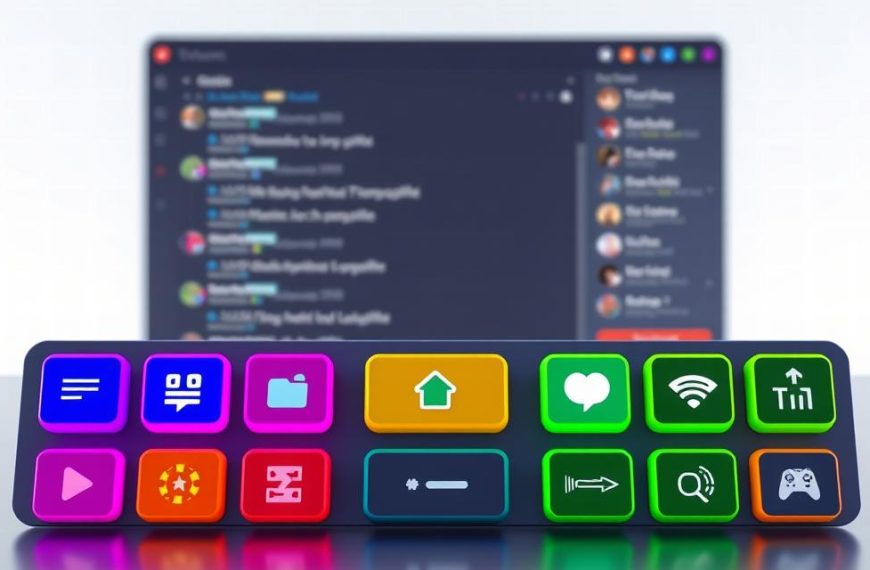The landscape of digital assistants has transformed dramatically since ChatGPT’s 2022 debut. Where once a single platform dominated conversations, dozens of specialised chatbot solutions now compete across industries. This evolution reflects a market prioritising depth over novelty, with established tools refining their capabilities rather than chasing headlines.
Modern systems combine advanced language models with practical features for business, education, and personal use. From social media management to academic research, today’s options cater to specific needs rather than offering generic responses. The challenge lies in identifying which solution delivers genuine value for individual requirements.
Our evaluation criteria focus on three core aspects: response accuracy, integration potential, and adaptability to user preferences. We’ve tested platforms against real-world scenarios – drafting professional emails, analysing complex data sets, and generating creative content. This approach ensures recommendations reflect practical utility, not just technical specifications.
As you explore this guide, consider how different chatbot features align with your objectives. Whether optimising customer service workflows or enhancing personal productivity, the right tool can revolutionise your digital interactions. The following analysis cuts through the noise to highlight 2024’s most effective solutions.
Introduction to AI Chatbots in 2024
Modern dialogue engines now interpret nuances in speech patterns, setting new standards for digital communication. These tools employ natural language understanding to analyse context, sentiment, and intent behind queries. Unlike older systems limited to scripted replies, current versions learn from interactions to refine their conversational depth.
Advanced language models process vast amounts of training data to handle unpredictable dialogue paths. This capability allows them to switch between technical support and casual banter without losing coherence. Many platforms now retain context from previous exchanges, creating personalised experiences for users.
The shift from decision-tree frameworks to machine learning architectures enables real-time adaptation. Businesses leverage this technology for analysing customer feedback data while educators use it to simulate tutoring sessions. Continuous updates ensure systems stay current with linguistic trends and cultural references.
Key differentiators in 2024 include error correction through user input and multi-format response generation. Solutions can now produce text summaries, visual aids, or code snippets based on conversation requirements. This versatility makes modern chatbots indispensable tools across professional sectors.
What ai chatbots are there
Today’s digital assistants span specialised roles, from coding partners to creative collaborators. Established platforms like ChatGPT maintain dominance through regular model updates, while newcomers carve niches with unique functionalities. This curated list highlights tools reshaping how professionals and individuals interact with technology.
Google’s Gemini excels in workspace integration, syncing seamlessly with Docs and Sheets. Anthropic’s Claude prioritises ethical outputs, offering transparency in decision-making processes. For social media managers, Meta AI provides tailored solutions across Instagram and WhatsApp. Microsoft Copilot stands out for enterprise users, embedding directly into Office 365 workflows.
“The market’s shifted from general-purpose tools to precision instruments – each designed for specific cognitive tasks.”
| Platform | Specialisation | Key Feature | Access |
|---|---|---|---|
| DeepSeek | Technical analysis | Open-source models | Web/API |
| Perplexity | Research assistance | Real-time citations | Mobile apps |
| Khanmigo | Education | Curriculum alignment | School portals |
Emerging apps like Poe aggregate multiple models, letting users switch between AI personalities. For developers, HuggingChat offers customisation through its model library. Personal productivity tools such as Merlin AI streamline workflow automation across browsers and mobile devices.
Choosing the right solution depends on required outputs and integration needs. Some platforms prioritise real-time information retrieval, while others focus on creative ideation. Most offer free tiers with premium access to advanced features, allowing users to test capabilities before committing.
Understanding How AI Chatbots Work
Behind every intelligent conversation with a digital assistant lies a sophisticated technical process. These systems combine linguistic analysis with adaptive learning to deliver human-like interactions. Three core components drive their operations: prompt interpretation, contextual understanding, and response generation.
Functionality of Natural Language Processing
Natural language processing (NLP) acts as the system’s linguistic decoder. When users submit prompts, algorithms break down sentence structures and word relationships. This analysis determines both literal meaning and implied intent through context clues.
Modern NLP engines map queries against vast data libraries containing idiomatic expressions and technical jargon. They identify whether a request needs factual answers, creative suggestions, or problem-solving approaches. This decision-making process occurs within milliseconds through layered neural networks.
Role of Machine Learning and Contextual Responses
Machine learning algorithms refine responses through continuous exposure to dialogue patterns. These systems track successful interactions and adjust future outputs accordingly. Over time, they develop specialised model behaviours for different conversation types.
| Component | Function | Key Feature | Example |
|---|---|---|---|
| NLP Engine | Syntax analysis | Intent recognition | Identifying urgent customer queries |
| ML Processor | Pattern learning | Response optimisation | Improving answer accuracy rates |
| Context Module | Dialogue tracking | Conversation history | Referencing previous user preferences |
“The true magic happens when NLP’s linguistic precision meets ML’s adaptive learning – that’s when digital assistants become genuine collaborators.”
Developers enhance these systems through parameter adjustments that prioritise specific data types. Some configurations might favour concise text outputs, while others enable extended creative exchanges. Multi-model architectures allow platforms to switch between these modes seamlessly.
Benefits and Use Cases for Business
Organisations across the UK are discovering how intelligent assistants drive measurable improvements in daily operations. These systems deliver strategic advantages through tailored automation and data-driven insights, particularly in customer engagement and internal workflows.
Streamlining Customer Service
Modern solutions handle over 60% of routine enquiries without human intervention. Key capabilities include:
- Instant resolution of common billing or delivery questions
- Seamless handover to staff for complex complaints
- Personalised recommendations using purchase history
Retailers report 40% faster query resolution times when combining automated systems with live support teams. The tool learns from every interaction, refining its knowledge base to address emerging customer needs.
Boosting Productivity with Automation
Beyond customer-facing roles, these platforms excel at eliminating repetitive tasks. Staff can redirect 12+ hours weekly towards strategic initiatives through features like:
- Automated meeting scheduling across time zones
- Real-time inventory updates for warehouse teams
- Instant report generation from raw data sets
Manufacturing firms using workflow automation note 30% reductions in administrative errors. The systems integrate with existing CRMs and ERPs, creating unified platforms for decision-making.
Practical use cases demonstrate how different industries benefit. Financial services employ chatbots for fraud alerts, while healthcare providers use them for appointment management. For businesses evaluating solutions, success depends on aligning features with specific operational challenges and user requirements.
Integration with Major Tech Platforms
Leading software ecosystems now embed conversational tools directly into their interfaces, eliminating app-switching fatigue. This seamless approach transforms how users interact with familiar platforms, merging AI capabilities with existing workflows.
Google Gemini Integration
Google Gemini operates as a central hub across the company’s services. Users can request Gmail searches while planning trips through integrated Hotels and Flights data. The platform summarises Drive documents during video calls and pulls real-time YouTube analytics for content creators.
Travel planning demonstrates its power. Ask Google Gemini to “find August flights to Edinburgh under £200” and it cross-references:
- Live pricing from multiple airlines
- Hotel availability near key landmarks
- Public transport options from arrival points
Microsoft Copilot in Action
Within Office 365, Microsoft Copilot revolutionises document creation. The integration analyses Excel spreadsheets to suggest pivot tables, then formats findings into PowerPoint slides. Drafting contracts in Word becomes faster with clause recommendations based on previous agreements.
Key features include:
- Data visualisation from raw figures
- Tone adjustments for audience alignment
- Cross-referencing company style guides
Both Google Gemini and Copilot extend functionality through mobile apps, syncing actions across devices. Third-party connectors like Zapier enable custom automations, letting businesses link these tools to 5,000+ other applications.
Chatbot Performance and Accuracy
Evaluating digital assistants requires measuring how effectively they balance technical precision with human-centric interactions. High-performing models deliver reliable results while maintaining natural dialogue flows, even during complex exchanges. This dual focus separates competent tools from exceptional ones in real-world applications.
Response accuracy remains the cornerstone of user trust. Top-tier systems achieve 85-92% correctness rates across factual queries and creative tasks. They cross-reference multiple data sources while flagging uncertain information – a critical feature for professional settings requiring verified analysis.
Conversational fluency extends beyond grammatical correctness. Effective chatbots adapt their tone to match user preferences, whether formal business communication or casual troubleshooting. Features like contextual memory allow referencing earlier discussion points, creating cohesive interactions that feel personalised.
- Average response time under 1.2 seconds
- 90%+ task completion rate for defined workflows
- 4.7/5 user satisfaction scores in enterprise trials
Leading platforms employ self-improvement mechanisms through:
- Real-time feedback integration
- Weekly model retraining cycles
- Multi-language support updates
Regular performance audits ensure models evolve with linguistic trends and domain-specific terminology. This continuous refinement process helps maintain results that align with shifting user expectations and industry standards.
Product Roundup of Leading AI Chatbots
Leading platforms now dominate specific sectors through tailored functionalities. Two solutions exemplify this trend through contrasting approaches – one offering comprehensive features, the other excelling in social ecosystem integration.
ChatGPT: The Benchmark AI Chatbot
OpenAI’s flagship product remains the gold standard for multifunctional assistance. Its text-to-image capabilities through DALL·E integration enable visual content creation alongside advanced data analytics. The platform’s Projects feature organises complex workflows, while Deep Research conducts multi-source investigations akin to human analysts.
Key strengths include:
- Voice conversations with natural intonation
- Canvas tool for collaborative editing
- Search functionality rivalling traditional engines
Meta AI for Social Media Solutions
Meta’s offering thrives within its native platforms – Facebook, Instagram, and WhatsApp. Users generate animated visuals directly in messaging threads, ideal for crafting engaging posts. The free image creation tool proves particularly valuable for small businesses managing tight marketing budgets.
| Platform | Specialisation | Key Features | Best For |
|---|---|---|---|
| ChatGPT | Multipurpose tasks | Advanced voice mode, code debugging | Professionals needing diverse capabilities |
| Meta AI | Visual content | In-app animation, cross-platform access | Social media managers |
While ChatGPT prioritises depth, Meta AI focuses on accessibility. For those seeking alternatives, our comprehensive comparison of top solutions explores additional options. The choice ultimately depends on whether users value cutting-edge innovation or seamless social media integration.
Comparison of LLMs and Reasoning Models
The evolution of conversational technologies hinges on two distinct approaches: language prediction systems and logical processors. While both power modern digital assistants, their operational frameworks address different cognitive challenges.
Strengths and Limitations of LLMs
Large language models excel in generating coherent text by analysing patterns across billions of documents. Their training on vast data sets enables fluent responses to diverse queries, from poetry composition to technical explanations. However, these systems often falter with multi-step calculations or scenarios requiring strict logical progression.
Recent improvements focus on enhancing factual accuracy through real-time verification processes. Some models now cross-reference up-to-date sources before generating answers, reducing reliance on outdated training data.
Advances in Reasoning Models
Specialised reasoning models adopt a methodical approach to problem-solving. By breaking tasks into sequential steps, they demonstrate their analytical process transparently. This architecture proves invaluable for mathematical proofs or strategic planning scenarios where justification matters as much as the final answer.
Modern iterations combine reduced training data requirements with enhanced deduction capabilities. Techniques like chain-of-thought prompting allow these models to tackle complex queries that traditional language systems might misinterpret. Their growing integration with LLMs creates hybrid solutions balancing linguistic flair with structured logic.
















